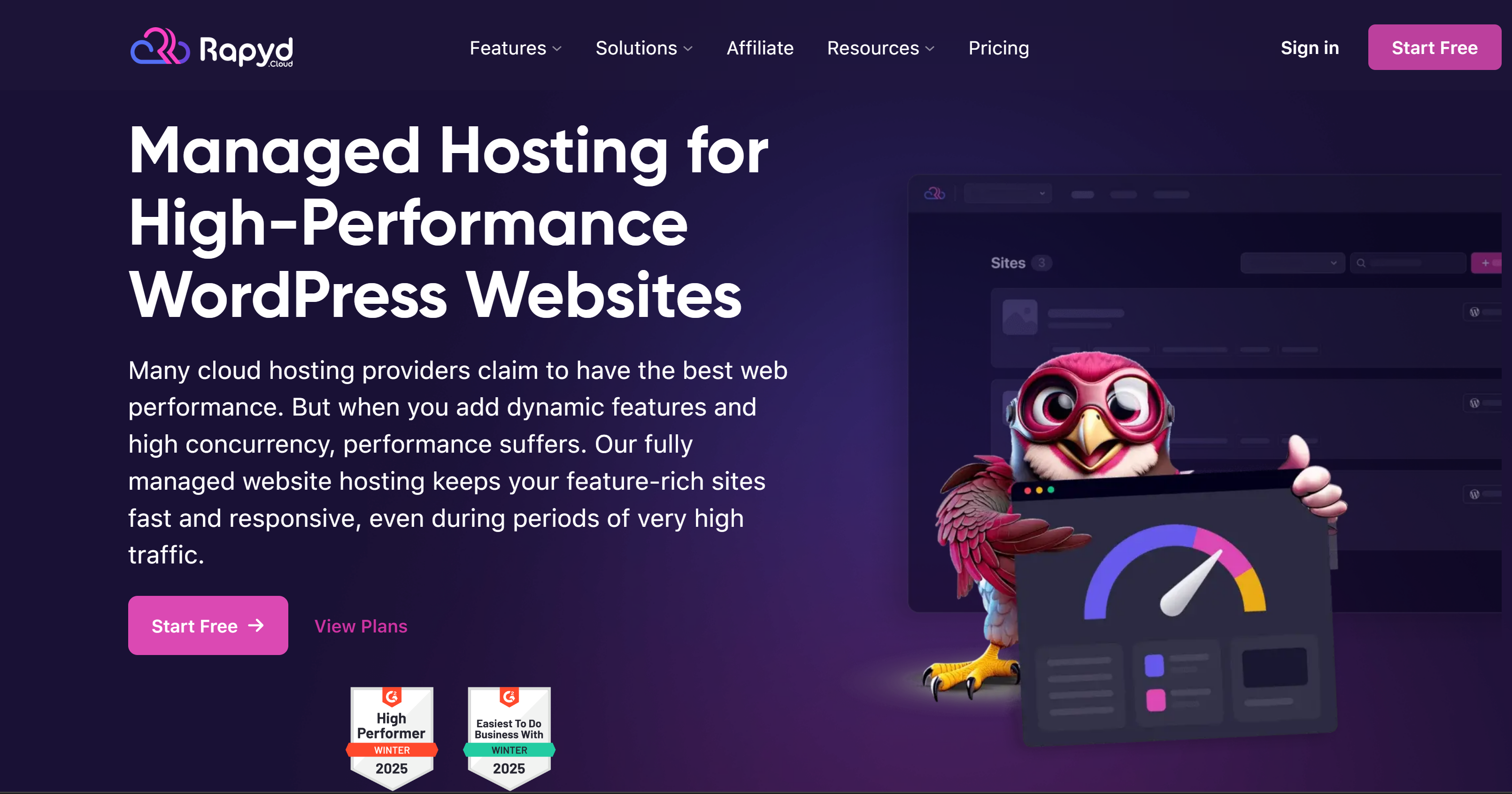Is Rapyd Cloud Worth It in 2025? My Hands-On Hosting Review

Like me, you’ve probably wrestled with hosting providers, looking for that sweet spot — something that’s fast, easy to use, secure, and can actually handle a site that’s growing.
I recently came across Rapyd Cloud. They highlight their ability to handle high-traffic WordPress sites with exceptional performance.
So, I decided to test Rapyd Cloud myself. I set up a site, ran performance checks, and explored its features. I wanted to see if it lives up to the hype and if it’s actually a good option for freelancers looking to build a solid online presence.
In this review, I’ll share my hands-on experience with Rapyd Cloud. I will lay it all out, the good, the bad, and the maybe-needs-some-work.
Ready to experience performance-driven hosting? Sign up for Rapyd Cloud today, and use the discount code AKOLO to enjoy up to 25% off your subscription.
Who is Rapyd Cloud Ideal For?
I found Rapyd Cloud best for anyone who values speed, reliability, and user-friendly tools to manage WordPress websites seamlessly. Let me break it down for you.
1. Freelancers and Small Business Owners
One of the first things I noticed was how intuitive their dashboard is—it simplifies everything from adding new sites to managing backups.
But affordability is not the only factor. Features like real-time resource scaling can be lifesavers when you suddenly land a big project or experience unexpected traffic spikes. The 99.99% uptime guarantee ensures your portfolio or business site stays online, keeping your clients and customers happy.
What stood out to me most is the one-click staging environment. If you’ve ever worried about making live changes to a client’s site, this feature is a game-changer. You can test updates or new designs without risking downtime or errors.
Ready to scale your freelance or small business site with ease? Try Rapyd Cloud today and experience its intuitive tools and unmatched reliability.
Start your 3-day free trial now.
2. Growing Online Businesses and eCommerce Stores
What impressed me the most was the platform’s ability to handle dynamic content and high traffic volumes without compromising speed or stability.
The Startup Plan is ideal for growing businesses. It supports 500,000 monthly visits, provides 100GB SSD storage, and includes 200GB of offsite backup storage. With features like Object Cache Pro and Redis caching with Relay, your store will seamlessly handle high concurrency—perfect for sites with complex product catalogs or real-time interactions.
3. Agencies and Developers
For agencies managing multiple projects or developers who need more control, Rapyd Cloud shines with its scalable infrastructure and developer-friendly tools.
The Performance Plan supports over 2.5 million monthly visits, provides 150GB SSD storage, and comes with 300GB of offsite backup storage, making it ideal for handling high-traffic client sites or complex applications.
One developer-friendly feature I loved was the WP-CLI and SSH access. These tools let you dive into the backend for advanced customizations, whether it’s running scripts or managing updates efficiently.
4. Online Learning Platforms
Online learning platforms require exceptional performance to deliver courses, videos, and interactive quizzes without lag. What stood out to me with Rapyd Cloud is its ability to handle dynamic content and high-concurrency traffic, making it ideal for sites like this.
With tools like the one-click staging environment, you can safely update your site, whether adding new courses or improving existing functionality. Plus, the intuitive dashboard makes managing content, traffic stats, and backups straightforward.
5. Membership Websites
Membership sites are another area where Rapyd Cloud excels. These sites typically involve dynamic user interactions, personalized dashboards, and exclusive content, all of which require robust performance and scalability.
Features like real-time resource scaling are crucial when you onboard new members or host live events. Additionally, ElasticPress ensures efficient search functionality, even for sites with a large library of member-exclusive resources.
6. Community Websites
Community websites rely heavily on real-time user engagement, whether through forums, chats, or group activities. Rapyd Cloud’s infrastructure is designed to support such dynamic environments.
For example, the Startup Plan provides ample storage and backup space, ensuring your site can store and secure user-generated content like posts, comments, and media. The Redis caching with Relay speeds up database queries, which is essential for quick-loading user profiles, posts, and messages.
Pros and Cons
Pros
- Exceptional performance even during high-traffic events.
- Built with scalability in mind for growing businesses.
- Tailored solutions for complex, dynamic websites.
- A user-centric dashboard that’s intuitive and efficient.
- Flexible plans catering to various business sizes and needs.
- Reliable uptime ensures uninterrupted user experiences.
- Security measures are proactive, not reactive.
- Designed to support eCommerce and membership platforms seamlessly.
- Ideal for developers with advanced tools and customization options.
- Seamless migration process handled by their team.
- Excellent customer feedback highlighting consistent quality.
Why settle for average hosting when you can have performance-driven solutions? See for yourself why Rapyd Cloud is a game-changer. Try their hosting plans for FREE today.
Cons
- Premium pricing for advanced plans.
Key Features & Benefits
- Real-Time Resource Adjustment: Automatically scales resources during high-traffic periods, ensuring uninterrupted performance.
- Free Object Cache Pro: Enhances database efficiency, making your website faster and more responsive.
- Redis Caching with Relay: Offers cutting-edge caching for unmatched speed and lock-free scalability.
- Performance Boosts: Manage short-term traffic surges without needing to upgrade your hosting plan.
- Integrated CDN: Rapidly delivers content globally, improving user experience and reducing latency.
- One-Click Staging; Test website changes in a secure environment before going live, minimizing risks.
- Intuitive Dashboard: User-friendly control panel simplifies website management and performance monitoring.
- Advanced Security Features: Includes firewall protection, DDoS mitigation, virtual patching, and proactive malware detection.
- Backup and Restore Tools: Easily create backups, roll back changes, or restore previous versions in a few clicks.
- Team Collaboration Tools: Assign roles and permissions for seamless teamwork on shared projects.
- WP-CLI and SSH Access: Allows developers to perform advanced backend operations with powerful command-line tools.
- phpMyAdmin Integration: Simplifies database management directly from the dashboard, saving time and effort.
- Free Migration Service: Transition your website to Rapyd Cloud without downtime or additional costs.
With Rapyd Cloud Hosting, you get a performance-focused, secure, and scalable solution for your WordPress site.
From running a blog to managing an eCommerce store or multiple client projects, Rapyd Cloud delivers the reliability and tools you need to succeed. Sign up today for a 3-day free trial and experience hosting that grows with you.
Pricing and Plans
Rapyd Cloud offers four hosting plans tailored to different needs:
- Lite
- Startup
- Performance
- Enterprise
These plans cater to everyone from freelancers and small businesses to high-traffic platforms and growing agencies. They make it easy to find your perfect fit without the commitment upfront.
They offer a 3-day free trial, allowing you to test the platform without any commitments. If you decide to continue, they offer a 14-day money-back guarantee for all new subscriptions.
This guarantee means you can get a full refund if you cancel within the first 14 days, though any add-ons or overages incurred during this period aren’t refundable. Refunds are processed within 7 days and returned to your original payment method.
Payment is convenient and secure, with options to pay via credit/debit cards or PayPal, giving you flexibility based on your preference.
Let me walk you through what each plan offers and help you decide which one might be the best fit for your needs.
1. Lite Plan
The Lite Plan is a great entry point if you’re just starting or managing a lightweight website. It’s affordable and includes:
- Support for 200,000 monthly visits.
- 30GB SSD storage, ensuring fast load times.
- A 99.99% uptime guarantee, so your site stays accessible.
- 30GB offsite backup storage to protect your data.
- Multi-layer proactive security and free migration services.
This plan is ideal for freelancers showcasing portfolios, personal blogs, or small websites with moderate traffic.
Pro Tip: If you’re just starting your freelance journey, it’s essential to have tools that support your growth. Check out these freelance writing resources to set yourself up for success.
2. Startup Plan
As your platform grows, the Startup Plan offers more resources to meet your needs. Priced at $89/month (with a 24-month term), it supports:
- 500,000 monthly visits for emerging platforms.
- 100GB SSD storage and 200GB offsite backup storage.
- Advanced tools like Object Cache Pro and Redis Caching with Relay to ensure superior performance.
- Multi-layer proactive defense and dynamic acceleration technology.
This plan works well for eCommerce stores, growing blogs, or membership sites handling increasing traffic and requiring robust performance.
3. Performance Plan
For high-traffic platforms, the Performance Plan delivers top-tier scalability and speed. At $269/month (with a 24-month term), it includes:
- Support for 2.5 million monthly visits.
- 150GB SSD storage and 300GB offsite backup storage.
- 146 auto-scaling PHP workers to handle significant traffic spikes.
- Enhanced support and advanced security measures, including vulnerability protection with PatchStack.
If you’re managing large-scale eCommerce platforms, high-traffic blogs, or agency portfolios, this plan ensures seamless performance under heavy workloads.
When deciding, think about your current traffic and growth goals. If you’re starting small, the Lite Plan gives you everything you need without overpaying.
For scaling businesses, the Startup Plan provides robust features at a reasonable price. And if your platform handles millions of visitors, the Performance Plan ensures you never sacrifice speed or reliability.
4. Enterprise Plan
Tailored solution for sites that have unique demands and require VIP support. This plan caters to large businesses with high traffic needs and provides features optimized for robust performance and scalability.
Exclusive Discount: Save Up to 25% with Discount Code AKOLO
Rapyd Cloud is offering an exclusive deal for new users. Use the discount code AKOLO during checkout to get:
- 25% off on annual subscriptions
- 10% off on monthly subscriptions
It’s the perfect time to try out their 3-day free trial, unlock premium features, and save on your hosting plan.
Here’s how to use the Promo Code AKOLO during checkout:
Step 1: Go to the Rapyd Cloud Pricing Page
Navigate to the Rapyd Cloud pricing page and select your preferred plan. For example, you might choose the Startup Plan for $89/month. Click “Add to Cart” to begin the checkout process.
Step 2: Create Your Account
You’ll be prompted to create an account or log in if you already have one. You can also choose to sign up with your Google account. After filling out the form, click Sign Up with Email. If you’ve previously signed up, simply log in with your existing credentials.
Step 3: Choose Your Plan and Payment Details
Once logged in, select your desired billing period and account type (Individual or Organization). On the payment page, you’ll see fields for your:
- Card Details (e.g., card number, expiration date, CVV)
- Billing Address (e.g., ZIP Code)
- Or, choose PayPal as your payment method.
On the left-hand panel, you’ll see the full price of your plan. For example, the Startup Plan with a 24-month term might display a total price of $2,136.
Step 4: Add and Apply the Discount Code
Below the payment details, you’ll find the “Add Discount Code” option. Click on it, and a text box will appear.
- Enter the promo code AKOLO in the text box.
- Click Apply to activate the discount.
You’ll immediately see the price update. For example:
- Before applying the promo code: $2,136.00
- After applying the promo code: $1,922.40
Step 5: Complete Your Checkout
Review the updated total and confirm the discount has been applied successfully. Once satisfied, click Start Your Free Trial to complete your signup.
With this exclusive discount, you can experience Rapyd Cloud’s premium hosting at a reduced price while benefiting from their 3-day free trial and 14-day money-back guarantee.
Ready to get started? Sign up with Rapyd Cloud, use the discount code AKOLO, and enjoy a seamless hosting experience.
Support Experience
Rapyd Cloud offers a comprehensive range of support options to ensure users receive timely assistance, no matter the time or complexity of the issue.
As I explored their support channels, I was impressed by their availability and responsiveness, which truly sets them apart.
24/7 Live Chat Support
Accessing the live chat was straightforward. After logging into the dashboard, I clicked the “Get Help” button in the top-right corner.
A chat pop-up appeared, and I was prompted to choose the type of help I needed: technical, sales, billing, or creating a ticket. I opted for technical support.
The chat began with a bot, which provided an initial response to my query. I asked how Object Cache Pro and Redis caching work together to improve database performance. The bot delivered a detailed and accurate explanation, highlighting their complementary roles in speeding up database queries and reducing server load.
If you’re unsure about next steps, the bot also lets you escalate to a human agent. I selected this option, and within a minute, I was connected to Niranjan, a support specialist.
Niranjan quickly understood my question, asked follow-up details, and suggested practical configurations for high-volume read and write operations. The chat was smooth, and I felt like I was speaking to someone who genuinely cared about resolving my concerns.
Impression: The live chat was fast, informative, and professional. The level of detail and attention is outstanding.
Knowledge Base
Rapyd Cloud’s knowledge base is another standout feature. It’s organized into clear sections, covering everything from basic setup to advanced troubleshooting.
I found it particularly helpful that you can search for specific topics, making it easy to locate relevant guides without wading through unrelated content.
Impression: For self-service, the knowledge base is incredibly user-friendly and well-maintained. It’s a great first stop for quick answers.
Support Ticketing
For more complex issues, Rapyd Cloud offers an efficient ticketing system. To create a ticket, start by opening the live chat from the dashboard and selecting the type of help you need. Among the options, click on “Create a Ticket.”
You’ll then receive a message saying, “We’ll be glad to create a ticket for you. Which department should we forward your ticket to?” The available options are Technical Support and Billing.
I chose Technical Support to test how well the system handles detailed technical queries. After specifying my concern about scaling server resources for high-traffic scenarios, the ticket was submitted. The dashboard provided a clear way to monitor the ticket’s progress, including timestamps and updates from the support team.
The response time was impressive—I received a detailed reply within a couple of hours. The agent addressed my query thoroughly, explaining the scalability options available within Rapyd Cloud plans and linking me to helpful resources in their knowledge base.
Impression: The ticketing system is an excellent option for addressing more nuanced or time-intensive issues. It’s easy to use, organized, and ensures you receive a thoughtful response from a specialized team. For complex inquiries requiring in-depth analysis, this system is highly effective.
Enhanced and Elite Support Options
For users on Enhanced or Elite plans, Rapyd Cloud takes support to another level. These plans offer:
- Dedicated account management for personalized guidance.
- Private Slack channels for direct communication with the sysops team.
- Tailored infrastructure solutions to customize server settings.
I tested these by exploring their private Slack channel. Setting up the channel was straightforward, and I appreciated the ability to communicate directly with their sysops team.
This option is perfect for users with critical hosting needs or those managing high-traffic sites.
The dedicated account manager was another highlight. After subscribing to an Enhanced plan for testing, I was assigned an account manager who proactively reached out to understand my requirements and provide tailored recommendations.
Impression: These premium features go beyond standard support, offering a truly personalized and responsive experience. They’re well-suited for businesses with complex hosting requirements or users who need high-priority assistance.
Direct Phone Support (Coming Soon for Elite Plans)
Rapyd Cloud is also preparing to roll out Direct Phone Support exclusively for Elite Plan users. This feature will allow users to speak directly with senior support engineers for real-time, personalized assistance to resolve urgent issues effectively.
Note: While I couldn’t test this feature since it’s not yet available, its upcoming launch highlights Rapyd Cloud’s focus on delivering top-tier support for high-priority users.
Overall Support Experience
From the live chat to the knowledge base, every interaction with Rapyd Cloud’s support team left a positive impression. Their agents are knowledgeable and patient, even when dealing with technical topics.
What I appreciated most was the seamless transition from automated responses to live agents—Rapyd ensures your queries are addressed promptly without compromising quality.
If you value fast, knowledgeable, and reliable support for your hosting needs, Rapyd Cloud delivers on all fronts.
User Experience: Registration & Control Panel
To fully evaluate Rapyd Cloud, I decided to test its registration process and control panel to gauge ease of use and practicality.
My goal was to assess how straightforward it is to set up an account and manage websites, especially for someone like me who values both performance and efficiency.
1. Registration
Step 1: Choosing a Plan
The registration process began on Rapyd’s homepage. From the main menu, I clicked on Pricing, which displayed a clear breakdown of their three plans: Lite, Startup, and Performance.
Each plan highlighted key features like supported traffic limits, backup storage, and tools like Object Cache Pro. For this test, I selected the Startup plan, which is designed for up to 500,000 monthly visits and offers enhanced caching tools.
To proceed, I clicked Add to Cart,
On the next screen, I was prompted to create my account. Rapyd offers two registration methods:
- Sign up with Google
- Sign up with email
I chose to sign up using my email. The form required basic information:
- First and last name
- Email address
- Password
- (Optional) Phone number
I also had the option to subscribe to Rapyd’s product updates and promotions. After entering my details and agreeing to the Terms of Service, I clicked Sign Up.
Step 3: Confirming the Order
Once my account was created, I was directed to an order confirmation page showing:
- Plan details: Startup Level 1 for 24 months.
- Subtotal: $2,136, with VAT added.
- Free trial: A 3-day trial before the first charge.
- Payment options: PayPal or credit/debit card.
The page also explained that after the free trial, my subscription would automatically renew unless canceled.
I entered my payment details, and upon completing the form, I received the following message: “Please check the email we sent to [your email] and click the link inside it to confirm your email address.”
I opened the email, clicked the verification link, and was redirected to Rapyd Cloud to continue setting up my account.
Step 4: Initial Setup Questions
After verifying my email, I was greeted by a short onboarding questionnaire designed to tailor the experience:
- Describe yourself:
Options included Freelancer, Business Owner, or Agency Owner.
I selected Freelancer. - Site type:
A list of site types appeared, including eCommerce, blogs, membership platforms, and more.
I chose an eCommerce store and blog, then clicked Continue.
This level of personalization stood out, as it allowed Rapyd to recommend tools and configurations based on my answers.
Step 5: Free Trial Overview
I was then directed to a dashboard welcoming me to Rapyd Cloud. It highlighted the key trial features and limitations:
- Trial sites are supported by temporary resources.
- Custom domain mapping, backups, and security tools are unavailable during the trial.
- Full features would unlock upon upgrading.
The dashboard provided two options:
- Create a blank WordPress site
- Upgrade to unlock all features
I chose to create a site during the trial period to see how the platform performed under these conditions.
Step 6: Creating a WordPress Site
Creating a WordPress site was simple and intuitive. Here’s the process:
- Site Name: I named my test site Angus.
- Domain: Rapyd auto-generated a subdomain: https://angus.ue1.rapydapps.cloud.
- Custom domains could only be added after upgrading.
- Location: I selected US East (Northern Virginia) for optimal performance based on my target audience.
- PHP Version: The default was 8.3, which Rapyd recommends for plugin compatibility.
- WooCommerce Option: A checkbox allowed me to pre-install WooCommerce.
After filling out these details, I clicked Add Site and waited a few minutes while Rapyd set up my environment. Once the process was complete, I was ready to explore the control panel.
If you’re new to hosting, here’s a step-by-step guide on installing WordPress to help you get started.
My Impression of the Registration Process:
The registration process and control panel exceeded my expectations. Signing up was seamless, and the onboarding steps ensured I was guided through every stage.
2. The Control Panel
The control panel immediately impressed me with its clean and organized layout. The homepage displayed an overview of my hosted sites with options to add new ones.
Key information, such as storage usage, traffic stats, and resource allocations, was presented visually, making it easy to grasp my site’s performance.
Dashboard Features in Detail
On the main page, I found a list of all hosted sites. Since this was a test, I only had one site. For each site, the panel displayed:
- Domain name
- WordPress version
- PHP version
- Storage and backup usage
- A prominent Add Site button made it easy to expand my hosting portfolio.
Clicking on my site opened a detailed page with several tabs, each offering access to specific tools and settings:
- Overview: Displays traffic stats, CPU, RAM usage, and storage. Visual graphs made it easy to monitor performance trends at a glance.
- WordPress: Direct link to the WordPress Admin dashboard for managing content and plugins.
- WooCommerce, Themes, Plugins: Allows quick access to manage e-commerce settings, customize themes, and update or rollback plugins.
- Stats: Offers detailed traffic metrics and resource usage, helping me identify potential performance bottlenecks.
- Backups: Shows storage usage and lets you create or restore backups. It clearly displayed my backup allowance (200GB) and the space I’d used so far.
- Settings: This tab lets you adjust configurations like PHP version, caching options, and domain management. The ability to manage domains, access logs, and adjust file permissions was a standout feature for developers.
User-Friendly Features
- Intuitive Navigation: The tabs were logically structured, making it easy to find the tools I needed.
- Real-Time Stats: The visual representation of metrics (e.g., traffic, CPU, and RAM usage) allowed me to monitor site performance at a glance.
- Quick Access to WordPress: The direct link to the WordPress Admin dashboard was a huge time-saver.
- Developer-Friendly Tools: Advanced features like PHP configuration, file manager access, and cache management made the control panel suitable for both beginners and experienced developers.
Rapyd Cloud’s control panel strikes an excellent balance between simplicity and functionality.
The layout is intuitive, with all essential tools easily accessible, yet it doesn’t compromise on advanced features.
What I Loved Most:
- The clean design that avoids clutter.
- Visual charts for real-time performance monitoring.
- Direct management of WordPress, WooCommerce, and plugins.
For anyone prioritizing efficiency and performance, Rapyd Cloud’s dashboard is a joy to use. It’s clear that a lot of thought has gone into making the user experience seamless and efficient.
Performance
To evaluate the real-world performance of Rapyd Cloud’s WordPress hosting, I simulated the steps an everyday user might take to build and test a WordPress site.
My goal was to see how the hosting would handle a content-heavy page and provide insights into how well it performs under typical usage conditions.
After logging into the Rapyd dashboard, I clicked on WP Admin to access the WordPress admin panel. Once inside, I created a page titled “The Ultimate Guide to Web Hosting Options”.
To make the page heavy, I added a substantial amount of content, including multiple images and embedded YouTube videos. This setup mirrors the kind of page a blogger or content creator might publish.
After finalizing the content, I published the page and prepared it for testing.
To analyze performance, I used GTMetrix, a tool known for providing detailed insights into a page’s loading speed and overall performance. It evaluates critical metrics such as:
- Largest Contentful Paint (LCP): Measures loading performance; ideally under 2.5 seconds.
- Total Blocking Time (TBT): Assesses how long the browser is blocked from responding to user input.
- Cumulative Layout Shift (CLS): Checks for visual stability during loading.
By using GTMetrix, I aimed to see how well Rapyd’s hosting handles a content-heavy page with images, videos, and dynamic elements.
GTMetrix Performance Results
I tested the page I created. Below are the results:
- Performance Overview
- GTMetrix Grade: A
- Performance Score: 94%
- Structure Score: 91%
- Key Web Vitals
- Largest Contentful Paint (LCP): 580ms – Excellent
- Total Blocking Time (TBT): 3ms – Excellent
- Cumulative Layout Shift (CLS): 0 – Perfect
- Load Times
- First Contentful Paint: 484ms
- Time to Interactive: 569ms
- Fully Loaded Time: 6.5s
- Onload Time: 4.5s
- Backend and Connection
- Time to First Byte (TTFB): 187ms
- Connection Time: 149ms
- Backend Processing: 38ms
The page’s largest element loaded in just 580ms, and the total blocking time was an impressive 3ms, ensuring a smooth user experience.
A TTFB of 187ms highlights Rapyd Cloud’s efficient server response times.
A CLS score of 0 indicates that the page remained visually stable during loading, which is crucial for user satisfaction.
While the performance was excellent overall, GTMetrix flagged a few optimizations that could enhance the page further:
- Static Asset Caching: Some static assets didn’t have an efficient cache policy, which could save up to 173KB.
- Third-Party Resource Loading: Lazy loading for third-party resources could improve Total Blocking Time.
- Use of a CDN: Six resources could benefit from a Content Delivery Network (CDN) to further enhance global load speeds.
Page Size and Requests
- Total Page Size: 2.50MB – Reasonable for a content-rich page but could be reduced further.
- Total Requests: 90 – The majority were JavaScript (31.1%) and fonts (10%), indicating areas where optimization could reduce load times.
Overall, the performance of Rapyd Cloud’s WordPress hosting exceeded my expectations. The platform handled a content-heavy page effortlessly, delivering excellent scores in key metrics like LCP and TBT.
The backend response times were swift, and the control panel tools made it easy to monitor performance in real-time.
If you’re looking for hosting that delivers top-notch speed and reliability for WordPress sites, Rapyd Cloud is an excellent choice.
With its proactive caching tools and strong backend performance, it ensures a seamless experience for both site owners and visitors.
Pro Tip: For even better performance, consider enabling Rapyd’s CDN and optimizing static assets to utilize their hosting capabilities fully. These tweaks can make an already fast site even faster.
And for more tips to improve your site performance, don’t miss this article on 7 blog headline types that can drive more traffic.
Rating Breakdown: The Good, The Bad, & My Take
After extensively testing Rapyd Cloud, here’s how I rated this provider across key areas of performance, usability, and support.
Each rating reflects my personal experience with the platform, giving you a transparent view of its strengths and areas for improvement.
| Category | Rating (Out of 10) | Why the Score |
| Performance | 9.5 | Exceptional speed metrics (LCP of 580ms, TTFB of 187ms) and strong caching features like Object Cache Pro and Redis. Slight deduction for CDN delays. |
| Ease of Use | 9.2 | The control panel is intuitive and well-organized, making site management simple. Minor deductions for trial limitations. |
| Support | 9.5 | 24/7 live chat with fast response times, detailed ticketing system, and proactive migration support. Premium plans offer extra features. |
| Security | 9.4 | Advanced DDoS protection, proactive patching, and malware detection. A slight downside is that some tools are unavailable during the trial. |
| Value for Money | 9.0 | Competitively priced for premium features, but upfront long-term payments may be a barrier for smaller users. |
| Trial Experience | 8.5 | The 3-day free trial is generous, but restrictions like no custom domains and limited security tools could be frustrating for some. |
| Scalability | 9.0 | Offers excellent tools for scaling, such as performance boosts and dynamic resource management. |
The Strengths in My Experience
Rapyd Cloud stands out for its performance-first approach. During my tests, the platform delivered exceptional speed metrics, with the test page achieving an impressive Largest Contentful Paint (LCP) of just 580ms.
The combination of Object Cache Pro and Redis caching worked seamlessly to improve response times and optimize database performance for dynamic content.
The user-friendly control panel was another highlight. From traffic and resource monitoring to direct access to WordPress tools like plugin management, Rapyd Cloud simplifies tasks that might otherwise require multiple third-party tools.
Support was also a major strength. The live chat impressed me with its responsiveness—under 45 seconds to connect with a knowledgeable agent. The ticketing system provided an organized way to resolve complex issues, and the proactive migration service ensured a seamless experience when moving sites to the platform.
The Not-So-Perfect Parts
While Rapyd Cloud impressed me in many areas, there were a few downsides. The upfront cost for long-term plans can feel steep for small businesses or budget-conscious users.
The free trial, while generous, comes with notable limitations. Features like custom domain mapping, advanced security tools, and backups are restricted during the trial period, making it harder to experience the platform’s full capabilities upfront.
My Honest Verdict
So, does Rapyd Cloud live up to the hype? In many ways, yes.
If you’re looking for a hosting provider that prioritizes speed, reliability, and user-friendly tools, Rapyd Cloud delivers. From its stellar performance metrics to its feature-packed control panel and proactive support team, this platform is tailored for WordPress users who want to scale without sacrificing ease of use.
Who Should Choose Rapyd Cloud?
- Content Creators and Bloggers: The platform’s speed and ease of use make it perfect for publishing multimedia-heavy blogs.
- Ecommerce Owners: WooCommerce-specific tools and robust caching ensure smooth shopping experiences.
- Agencies and Developers: Multi-site management, staging environments, and performance insights simplify complex projects.
- Community Owners: If you’re running a membership site, forum, or subscription-based platform, Rapyd Cloud’s ability to handle high concurrency and dynamic interactions ensures your community thrives without performance issues.
- LMS Site Owners and Educators: Online learning platforms demand speed and reliability to deliver courses, videos, and quizzes smoothly. Rapyd Cloud excels here, offering robust caching, seamless resource scaling, and uptime guarantees to ensure uninterrupted learning experiences.
Who Might Look Elsewhere?
- Small Businesses on Tight Budgets: The upfront costs may feel steep for users who can’t commit to a multi-year plan.
- Non-WordPress Users: If you’re not using WordPress, Rapyd’s specialized tools might not fit your needs.
Pro Tip: If you’re unsure about committing long-term, start with the free trial to test Rapyd Cloud’s performance using your actual site content and traffic patterns. It’s a great way to determine if it’s the right fit for your needs.
And here’s an exclusive deal: Use the discount code AKOLO at checkout to unlock 25% off annual subscriptions or 10% off monthly plans. Don’t miss this chance to save while enjoying premium hosting features.
Frequently Asked Questions
How beginner-friendly is Rapyd Cloud for non-technical users?
Rapyd Cloud is highly beginner-friendly. Its intuitive dashboard, one-click WordPress setup, and automated features like backups and staging environments simplify site management even for new hosting users.
Does Rapyd Cloud support WooCommerce?
Yes, Rapyd Cloud fully supports WooCommerce. You can opt to pre-install WooCommerce during site creation, and the hosting plan includes tools optimized for eCommerce, such as caching for product pages and real-time scaling for high-concurrency transactions.
What happens after the free trial ends?
After the 3-day free trial, you’ll need to upgrade to a paid plan to continue using Rapyd Cloud. Your site’s data and configurations remain intact, and all premium features, like custom domains and security tools, will be unlocked upon payment.
Is it possible to test site performance during the trial period?
Yes, you can test site performance during the trial. While some advanced features like backups and custom domains are limited, you can fully use caching tools and resource monitoring to evaluate hosting speed and reliability.
Do you want to take your website to the next level with hosting that delivers speed, reliability, and top-notch support? Don’t just take my word for it—experience Rapyd Cloud for yourself. Start your free trial today and see the difference it makes!






